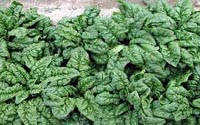Resource Library
Plant of the Week: Spinach
The University of Arkansas System Division of Agriculture does not promote, support or recommend plants featured in "Plant of the Week." Please consult your local Extension office for plants suitable for your region.
Plant of the Week
Spinach
Latin: Spinacia oleracea

It's over. You missed it. While Popeye wasn't in attendance at the International Spinach Conference, he served as a kind of unofficial mascot for the group of about 60 scientists, growers and packers who met to discuss all things spinach.
Teddy Morelock, the vegetable breeder with the University of Arkansas Department of Horticulture who has the largest publicly-funded spinach breeding program in the nation, hosted the group.
Spinach (Spinacia oleracea) is a cool season vegetable of the Chenopodium family that is most closely related botanically to beets, Russian thistle and the common weed lamb's quarter. It's grown only for its deep green, succulent leaves which are an extremely rich source of vitamin A.
Spinach plants produce two distinct leaf forms, the savoy-leaf and the flat-leaf types. The savoy-leaf type is extremely crinkled and is primarily used for the fresh market because of its superior eye appeal.
The term "savoy" appears to come from the region in France by the same name where the instructions for preparing spinach for the table included thoroughly washing it 12 times. The flat-leafed types are mostly grown for processing because they are easier to wash free of grit.
Spinach originated in Persia (today's Iran) from where it was exported to China by the 7th century. It made its way to Europe about the time of Marco Polo's visit in the 14th century and arrived in the New World with the earliest settlers. During the early years of life in America, it seems to have been just another vegetable, but all of that changed when it got its very own press agent.
Popeye's association with spinach is a bit more murky. In 1911, Polish scientist Casimir Funk identified a substance he called "vital amine" in unpolished rice which prevented beriberi. About the same time, British scientist Frederick Hopkins demonstrated that something in milk prevented blindness in his lab rats. Fittingly, University of Wisconsin scientist E V. McCollum isolated two necessary fractions, a fat soluble A and a water soluble B, as essential for normal development in rats. In 1930, the chemical structure of vitamin A was identified.
During the 20's and 30's the U.S. Department of Agriculture used its home economist staff to promote the use of leafy green vegetables such as spinach as a source of vitamin A.
Popeye's use of spinach, no doubt taken from the ongoing research in vitamins, provided just the right elixir to enable him to best Bluto at every turn. The publicity caused spinach to rise to the third most popular vegetable served to children.
At least two towns - Alma in Arkansas and Crystal City, TX - claim to be the spinach capitol of the world and they both have Popeye statues to prove it.
But there seems to be a bit of delusion involved with boosterism in both communities for the Central Valley of California is where over half of the nation's spinach is produced. Springdale, with its own nifty Popeye statue at the Allen Canning Plant offices, never got worked up enough to enter the race to become Ground Zero of the spinach world.
Spinach can be grown in three distinct seasons in Arkansas gardens. The fall planting is made in mid to late August with leaves ready to pick in November. In central and south Arkansas, an overwinter planting can be made with seeds planted in late October for early spring harvest. A spring planting can be made by planting seeds as early as the ground can be worked in February. Spinach is usually large enough to cut about eight weeks after planting.
By: Gerald Klingaman, retired
Extension Horticulturist - Ornamentals
Extension News - March 1, 2002
The University of Arkansas System Division of Agriculture does not maintain lists of retail outlets where these plants can be purchased. Please check your local nursery or other retail outlets to ask about the availability of these plants for your growing area.